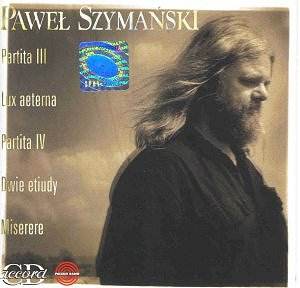We are told that Szymanski
developed his own voice early.
Partita III starts
as a tumultuous glocken fusillade of
activity for the full orchestra and
the harpsichord. It sounds rather like
a psychedelic Bach fugue - a supercharged
Martinů
or Poulenc concerto. This whirling activity
stops and starts, punctuated by silences
and modest gentle querulous sighs from
the strings. The dreamy focusing and
blurring melts into a slow motion vision
rather along the lines of the 'trippy'
dissolution sections of Valentin
Silvestrov's Fifth Symphony. The harpsichord
touches in ringing silvery patterning
like clockwork running down.
Partita IV
is the most avant-garde sounding of
the works here. It was commissioned
by BBC Northern Ireland and premiered
in 1987 by the Ulster Orchestra conducted
by Lionel Friend. Again it is constructed
from repeated cells in evolution but
here the incidents are furious and typical
of the Polish 1960s avant-garde. Even
the long-held quiet notes are ambiguously
dissonant (5.50) though they do gain
an almost sentimental warmth (11.23)
made equivocal by moans from the brass.
This piece represents an evolutionary
progress from vehemence to silence.
The Two Studies
for solo piano peck and impact
in slow progression - again sounding
both familiarly in the style of Bach
yet dissected in an unhurried and surprisingly
avant-garde exhibition. The second study
moves to slough off the first at about
6.03. The second glitters in Mozartian
gemwork.
Lux Aeterna is
based on a theme from l'Homme Armée
which is sung as if diced into sections
presented haltingly cocooned in a tinkling
commentary from the ensemble. Everything
is presented with clarity and in a halo
of warmth contributed by harp, piano,
celesta and vibraphone. Time and again
with Szymanski iterative bell sounds
real or evoked are crucial. So it is
with Lux Aeterna.
The Miserere
is stunningly recorded as are all the
other works here. Like the Lux Aeterna
there is an archaic plainchant feeling
to this work for chamber choir, a quartet
of cellos plus harp and vibraphone.
There are whispers, glintings, sighs
and sinuous wails and stratospheric
sirening from the cellos.
There is some extraordinary
writing here. If you want to keep up
to date then don't miss Partita III
and Lux Aeterna. There will
I am sure be much more to be heard from
Szymanski.
Rob Barnett
The
entire CDAccord catalogue is available
from MusicWeb

![]() for
details
for
details